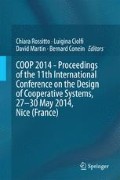Abstract
Communities present considerable challenges for the design and application of supportive information technology (IT), especially in loosely-integrated and informal contexts, as it is often the case of Communities of Practice (CoP). An approach that actively supports user communities in the process of IT appropriation can help alleviate the impossibility of their members to rely on continuous professional support, and even enable complex forms of cooperative tailoring of their artifacts. The paper discusses the property of the accountability of IT applications as one of the basic enabling conditions for the appropriation of the technologies by their end-users, and for its most mature and sustainable form, that is End-User Development (EUD). We illustrate a framework, called Logic of Bricolage (LOB), proposed to both end-users and interested designers to describe (and make accountable) their EUD environments and systems, and facilitate both local appropriation and the sharing of experiences of IT adoption in CoPs.
Access this chapter
Tax calculation will be finalised at checkout
Purchases are for personal use only
Notes
- 1.
- 2.
This task is less detailed than in the other two cases as the mentioned paper does not give all the necessary details.
References
Ardito C, Buono P, Costabile MF, Lanzilotti R, Piccinno A (2012) End users as co-designers of their own tools and products. JVLC 23(2):78–90
Bowers J, Button G, Sharrock W (1995) Workflow from within and without: technology and cooperative work on the print industry shopfloor. In: ECSCW’95. Kluwer Academic Publishers, Dordrecht, pp 51–66
Bodker S (2006) When second wave HCI meets third wave challenges. ACM Press, New York, pp 1–8
Cabitza F, Simone C (2010) WOAD: a framework to enable the end-user development of coordination oriented functionalities. JOEUC 22(2):1–20 (IGI Global)
Cabitza F, Simone C (2012) Affording mechanisms: an integrated view of coordination and knowledge management. CSCW 21(2):227–260
Cabitza F, Simone C (2014) Building socially embedded technologies: implications on design. In: Designing socially embedded technologies. Springer (forthcoming)
Cabitza F, Simone C, Sarini M (2009) Leveraging coordinative conventions to promote collaboration awareness. CSCW 18(4):301–330
Cabitza F, Simone C, Locatelli MP (2012) Supporting artifact-mediated discourses through a recursive annotation tool. In GROUP '12: Proceedings of the 17th ACM international conference on Supporting group work. ACM, New York, NY, USA, pp 253–262
Cabitza F, Fogli D, Piccinno A (2014) “Each to his own”: distinguishing activities, roles and artifacts in EUD practices. In: Empowering society through digital innovations, LNISO. Springer, Berlin
Cappiello C, Daniel F, Matera M, Picozzi M, Weiss M (2011) Enabling end user development through mashups: requirements, abstractions and innovation toolkits. LNCS, vol 6654, Springer, Berlin, pp 9–24
Carroll JM, Kellogg WA, Rosson MB (1991) The task-artifact cycle. In: Designing interaction: psychology at the human-computer interface. Cambridge University Press, Cambridge, pp 74–102
Costabile MF, Fogli D, Mussio P, Piccinno A (2007) Visual interactive systems for end-user development: a model-based design methodology. Trans Syst Man Cybern 37(6). IEEE
Dourish P (2001) Where the action is: the foundations of embodied interaction. MIT Press, Cambridge
Dourish P (2003) The appropriation of interactive technologies: some lessons from placeless documents. CSCW 12:465–490
Fischer G, Scharff E (2000) Meta-design: design for designers. In: DIS’00 ACM, New York, pp 396–405
Gasser L (1986) The integration of computing and routine work. ACM TOIS 4(3):205–225
Halverson C, Ackerman M, Erickson T, Kellogg WA (eds) (2008) Resources, co-evolution and artifacts: theory in CSCW. Springer, Berlin
Handel MJ, Poltrock S (2011) Working around official applications: experiences from a large engineering project. In: CSCW’11: ACM, pp 309–312
Lanzara G (1999) Between transient constructs and persistent structures: designing systems in action. J Strateg Inf Syst 8:331–349
Locatelli MP, Simone C (2012) End-users’ integration of applications and devices: a cooperation based approach. In: From research to practice in the design of cooperative systems: results and open challenges. Springer, Berlin, pp 167–181
Myers BA, Pane JF, Ko A (2004) Natural programming languages and environments. Commun ACM 47(9):47–52
Orr J (1996) Talking about machines: an ethnography of a modern job. Cornell University Press, NY
Pipek V, Kahler H (2006) Supporting collaborative tailoring. In: End user development, vol 9. Springer, Berlin
Pipek V, Rosson MB, Stevens G, Wulf V (2009) Supporting the appropriation of ICT: end-user development in civil societies. In: Learning in communities. Springer, Berlin, pp 25–27
Simon HA (1996) The sciences of the artificial, 3rd edn. MIT Press, Cambridge
Syrjaenen AL, Kuutti K (2011) From technology to domain. ACM Press, New York, pp 244–251
Wenger E (1998) Communities of practice: learning, meaning, and identity. Cambridge University Press, Cambridge
Won M, Stiemerling O, Wulf V (2006) Component-based approaches to tailorable systems. In: End user development, vol 9. Springer, Berlin, pp 115–141
Author information
Authors and Affiliations
Corresponding author
Editor information
Editors and Affiliations
Rights and permissions
Copyright information
© 2014 Springer International Publishing Switzerland
About this paper
Cite this paper
Cabitza, F., Simone, C. (2014). “Through the Glassy Box”: Supporting Appropriation in User Communities. In: Rossitto, C., Ciolfi, L., Martin, D., Conein, B. (eds) COOP 2014 - Proceedings of the 11th International Conference on the Design of Cooperative Systems, 27-30 May 2014, Nice (France). Springer, Cham. https://doi.org/10.1007/978-3-319-06498-7_11
Download citation
DOI: https://doi.org/10.1007/978-3-319-06498-7_11
Published:
Publisher Name: Springer, Cham
Print ISBN: 978-3-319-06497-0
Online ISBN: 978-3-319-06498-7
eBook Packages: Computer ScienceComputer Science (R0)

